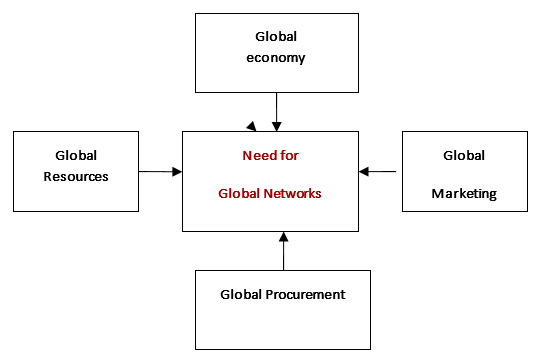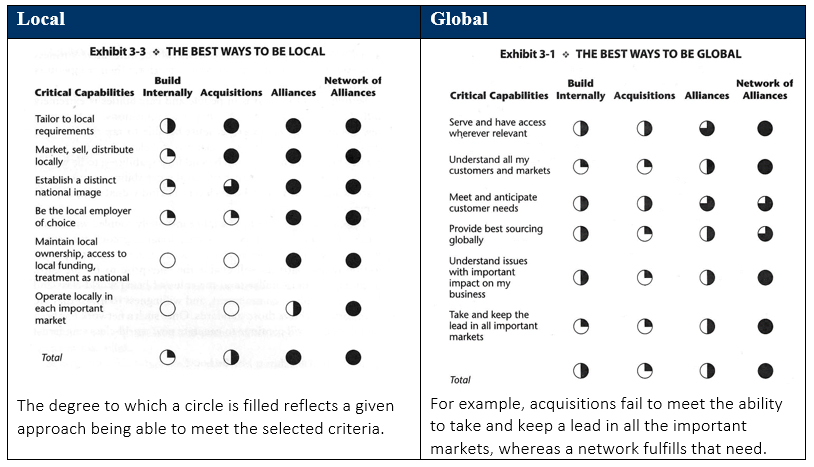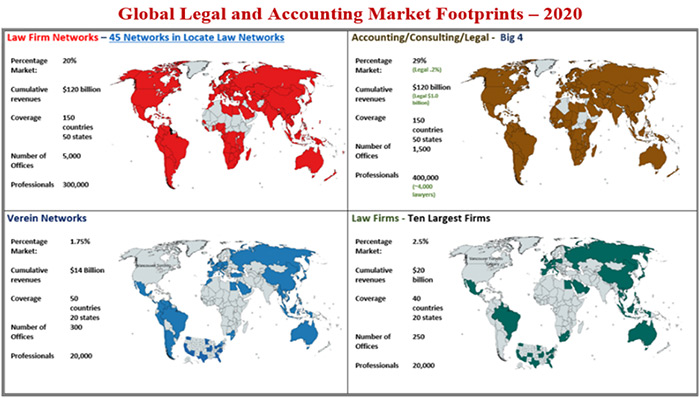Networks’ competitive advantages in the time of Covid-19
Back to Alternative and New Law Business Structures (ANLBS) Committee
Back to Professional Ethics Committee publications
Stephen McGarry
WPP, New York
smcgarry@peoplepc.com
In March 2020, the legal and accounting professions woke up to two very different realities.
The accounting profession woke up to something they had operationally prepared for years. For accounting networks, Covid-19 was not only business as usual but a bonanza of new work. Trillions of dollars were pumped into the United States economy, with other countries and governments following suit. All these funds have to be accounted for, for shareholders and the governments.
The legal profession has been harder hit.[1] The legal profession was faced with a different reality. It is hierarchically structured between lawyers and non-lawyers[2] and in recent years has been threatened by the Big Four accounting firms (Deloitte, EY, KPMG and PwC) entering the legal profession in 100 countries. The coronavirus introduced a new motivation for clients to meet with their accountants and Big Four lawyers. The legal profession’s attempts to defend itself against the effects of the pandemic became harder because it had not innovated to the same degree as the accounting profession.[3] There was no need for accountants to attend ‘How to do Zoom’ webinars.
The disruption to the legal profession struck firms of all sizes.[4] Stock market plunges threatened deals that had already been negotiated. Revenue sources were called into question. Overnight, large law offices were vacated for lawyers to work from home. Summer associate offers were rescinded. Tens of thousands of lawyers were furloughed.[5]
Networks in both professions met challenges, but the different professional challenges reflect the history of each profession.[6] The accounting networks, having competed with the Big Four networks for decades, never missed a beat. Legal networks faced new challenges. Social distancing eliminated a key component of their operations and source of revenue: meetings.
The good news is that, on a macro level, a network’s structural model is similar for both professions. This creates operational flexibility and continuous opportunities to expand at lower costs. Law firms with no network memberships found themselves literally on their own. Network members have a lot of friends.
Networks
All businesses represent a pool of financial and human capital that creates a product or performs a service. This capital can be configured in an unlimited number of ways to achieve specific objectives for the service provider or manufacturer. In international professional services, the traditional delivery methods are operations using a controlled entity or membership in an association of independent service providers. These associations are commonly referred to as ‘professional services networks’. Law firm networks are one type of professional services network.

Figure 1: benefits of networks
Network members are potentially well-positioned in comparison to firms that do not belong to a network. They can be in a similar position to the Big Four and the 25 largest accounting networks and associations. Why?
In today’s world, there is a need for networks. There is no company or business large enough to create and manufacture their own products. Companies are dependent on others to provide the required services. It is economically more efficient. Figure 1 summarises why networks are necessary.[7] Networks operations apply equally to the creation and distribution of information, which is at the heart of accounting and law.
The respective strengths of network membership and the ability to use a network to achieve specific tasks were well illustrated in a book by Cyrus Freidheim, entitled The Trillion Dollar Enterprise (1999). In his book, Freidheim evaluates many different types of networks. His premise is that every network has potential defined by the human, technical, and financial interests of its members. The book sets out some standards by which to measure the effectiveness of a network as a business model in expansion to local and global markets.[8]
Figure 2 illustrates how networks can effectively assist members in building a presence in all local markets, as well as developing a global presence to meet their clients’ needs. The charts distinguish between a company building internally, acquiring another company or becoming a member of a network. The greatest strength of a network is that the member can have a local presence everywhere to serve clients.

Figure 2: local and global networks
When one compares the global and local coverage of accounting and legal networks to the coverage of the largest law firms, the difference is stark. The footprint of the largest law firms is, on average, fewer than 20 countries (see Figure 3).
Figure 3: global legal and accounting market footprints 2020

This is also illustrated by their global footprint as a percentage of lawyers outside of the United States (see Figure 4).[9] For the largest firms headquartered in other countries, the difference is even more pronounced. While all firms have their individual networks of ‘best friends’, this is quite different from having a formal network system operated independently.
Figure 4: Differences in NLJ firm geographic coverage

The charts reflect the enormous costs of internally developing a global business by even the largest law firm. For a professional services firm to start a series of branch offices that will develop the same market penetration may take a decade and cost millions of dollars. However, in a network, these costs are already allocated among the full membership. The cost for future members to gain direct and immediate access to these resources is de minimis.[10]
These connections translate into value for a networked firm’s clients. Having reliable information about global markets during times of crisis is even more important. Network members can tap into a wealth of information in minutes. This applies whether they are the Big Four networks or a smaller accounting or legal network. Demonstrating this ability to clients is a key marketing advantage. Technologies like Zoom, Skype, WebEx, Microsoft Teams, and Google Meet level the playing field.
The four elements of globalisation reflect solutions to the effects of the pandemic itself. It is global. Global resources can be deployed for clients. Those who have information resources can market it globally. Serving clients requires a local presence. Accounting and law firms are by definition local, regardless of the number of offices.Networks allow for the representation of business clients outside of a firm’s principal country. As these clients expand, they can use the ‘local’ firm.
Coronavirus has all but eliminated in-person meetings[11] and modified a central element of the networks: relationships. It challenges each member’s firm and the networks themselves on how to maintain and create relationships. This goes to defining how networks work.
How do networks work?
Every network is different and each is a product of their history. For example:
-
How were the members selected?
-
What were their specific criteria?
-
What were new members’ expectations?
-
Who operated the network in the beginning?
-
What were the level of dues?
-
Who are the original directors and officers?
-
Do they change?
-
Are there formal bylaws?
-
Who decides on the strategy?
These elements are part of a network’s DNA.
As the network matures, it can go in two directions. Sometimes new members are added while the structure and operations stay constant. Many networks are seen as the property of one or a few member attorneys. When this happens, it is very difficult to be proactive because there are few new participants and the management may not change. There may be a small administrative non-lawyer staff whose duties are aligned with maintenance rather than innovation.
On the other hand, the DNA of other networks points to a different development. Even though the largest networks began with no staff, today they may have a non-lawyer staff of ten, 20, or even 30 professionals. Dues have been increased to support these efforts. There may even an annual forum for managing partners. In some networks, firms do extensive internal marketing within their own offices. Logos are prominently featured on the firm website, the firm brochure and on the letterhead. Reports are made on the network at firm meetings, which generally include discussions regarding referrals and the strategic use of the network. These resources and relationships are now crucial, given the current pandemic.
Example: How to optimise networks to obtain clients at virtually no cost
All networks, no matter their level of development, have opportunities to enhance their membership value and solidify the network. Networks have resources developed over decades. Building on these relationships costs comparatively very little. When a new member joins, it buys into this investment. Many networks charge a considerable initiation fee to compensate for the cost of the investment of earlier members. The annual dues paid for each member are relatively small because of that initial investment by other members.
Networks focus on creating tools that members can use. This begins by asking what the clients of each member firm want. The reason why the network system works so well is that it can address a diversity of interests. Among the members is an unlimited number of interest groups. The question is how this knowledge can be captured and then leveraged to benefit members and ultimately their clients.
The network’s management must show members how to locate these groups already in the system. If such a group doesn’t exist, they can create one. The member firm can leverage their internal knowledge and share it with the rest of the network. This can be extended to clients both locally and globally. If the network is not promoted in their firm, however, these potential opportunities are wasted.
How is this done? If a network includes taking ten practice interests committees (for example, taxation, environmental, alternative dispute resolution and natural resource, among others), they can be used in a number of ways in a crisis. The network needs only collect one contact at each firm for each practice. This information can easily be used to create a practice matrix or directory for use of the attorneys. They could circulate an online directory to every one of those individuals. If there are ten practice areas for a network of 100 firms, this is a directory of 1,000 lawyers.
The network could also create ten standardised brochures to send to clients, one for each practice area that addresses their specific issues. If one member of a 100-member network sends out ten brochures to clients, this is 1,000 practice brochures sent to specific individuals. If each contact sends 100, that becomes 10,000 brochures. If all ten groups did the same, that is 100,000 brochures. The total cost is essentially zero. Updates can be sent periodically since contact data has already been collected.
These are just two examples of how networks and their members can leverage their relationships built on decades of trust. The Covid-19 crisis can create the opportunity to better assist existing clients and develop new ones.
Summary
The network model provides the best model for operating in a global market. Crises like a pandemic can create serious issues in international supply chains because of the interruption to physical distribution. Professional services, meanwhile, have no such impediments with the free flow of information. Technology provides continuity.
Accounting firms that are also network members have not been impacted by Covid-19[JKK5] to the same degree as law firms. The size, scope, and preparedness of the Big Four provides a huge advantage in their diversification offering a distinct advantage over law firms of all sizes. This is the result of their billions in revenue, location in more than 100 countries and – most importantly – their existing sophistication.
However, members of law firm networks find themselves in an ideal position by retaining a global and local presence. Further investment is de minimis since the network system has been built over decades.
The challenge is to recognise these advantages, which requires innovation at the network level that is carried through to the member firm level and ultimately to clients. It is not that difficult with a network.
[2] Mark A Cohen, ‘After-Corona Legal Careers: More Choice And Less Practice’, Forbes, 11 May 2020.
[3] ‘EY Outlines Its Strategy in Legal and Approach to Servicing Law Departments’, LegalLaw.com, 5 January 2020; ‘Big Four Legal Arm Head Says Covid-19 Will Change the Way Law is Practiced’ Law.com, 24 March 2020.
[4] Hugh A Simons, ‘As Salary Cuts Move to Higher-Profit Firms, What Happens Next?, Law.com, 15 May 2020; ‘Coronavirus Is Taking Its Toll On Big Law’, Bloomberg Law (14 May 2020) See www.youtube.com/watch?v=hO-1PjEZkzw&t=6s.
[6] For the history of accounting networks, see Mark Stevens, The Big Six (1991); Stephen A Zeff, ‘How the U.S. Accounting Profession Got Where It Is Today’, 17 Accounting Horizons p 189 (Sept. 2003); H Lenz & M Schmidt, ‘Das Strategische Netzwerk als Organisationsform internationaler Prüfungs – und Beratungsunternehmens – die Entwicklung zur, Global Professional Service Firm’, in J Engelhard & EJ Sinz, Kooperation im Wettbewerb. Wiesbaden 113-150 (1999); J. Klaassen & J. Buisman, ‘International Auditing’, in Comparative Int’l Acct. (Chris Nobes & Robert Parker Eds, 6th ed 2000); Michael Barrett, et al, ‘Globalization and the Coordinating of Work in Multinational Audits’, 30 Acct, Orgs and Soc’y 1, pp 1–24 (2005).
[7] Jagdish Sheth, ‘Strategic Importance of Information Technology’, Advances in Telecomm Mgmt, 1994, at Volume 4, pp 3–16; \ BM Gilroy, Networking in Multinational Enterprises: The Importance of Strategic Alliances (1993); R Gulati et al, ‘Strategic Networks’, 21 Strategic Mgmt J, pp 203-215 (2000); Tim Turley, Winning in a Polycentric World, EY, see www.ey.com/GL/en/Issues/Business-environment/Winning-in-a-polycentric-world--globalization-and-the-changing-world-of-business---Winning-in-a-world-with-many-centers.
[8] Cyrus Freidheim, The Trillion-Dollar Enterprise: How the Alliance Revolution Will Transform Global Business (1999).
[9] Nicholas Bruch, ‘ALM Legal Compass Snapshot: The NLJ 500’, Law.com (28 June 2018). See www.law.com/2018/06/28/alm-legal-compass-snapshot-the-nlj-500?et=editorial&bu=ALM%20Intelligence&cn=20180628&src=EMC-Email&pt=Analyst%20Brief.
[10] See infra Chapter 3, History of Professionals Services Networks – Why Do They Matter?
[11] 'Organisations are conservative. They will not take the risk of infection of any of their members'. Jeffrey S. Tenenbaum & Nisha G. Thakker, ‘Legal Strategies for Nonprofit Meetings during Covid-19’, The Nonprofit Times, (25 March 2020) See www.thenonprofittimes.com/legal/legal-strategies-for-nonprofit-meetings-during-covid-19.